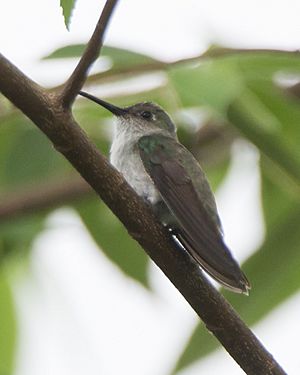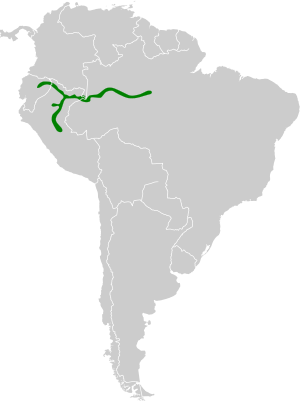Olive-spotted hummingbird facts for kids
Quick facts for kids Olive-spotted hummingbird |
|
|---|---|
 |
|
| Conservation status | |
| Scientific classification | |
| Genus: |
Talaphorus
|
| Species: |
chlorocercus
|
 |
|
| Synonyms | |
|
Leucippus chlorocercus |
|
The olive-spotted hummingbird (Talaphorus chlorocercus) is a small, fast-flying bird. It belongs to the "emeralds" group of hummingbirds. You can find this special bird in parts of Brazil, Colombia, Ecuador, and Peru.
Contents
About Its Name and Family
Scientists group living things into families. This helps us understand how they are related. The olive-spotted hummingbird was once in a group called Leucippus.
But in 2014, a new study looked closely at its DNA. This study showed that the Leucippus group was not quite right. So, scientists moved the olive-spotted hummingbird to a different group. This new group is called Talaphorus.
The olive-spotted hummingbird is the only bird in its Talaphorus group. It does not have any different types or subspecies.
What It Looks Like
The olive-spotted hummingbird is about 12 cm (4.7 in) long. That's about the length of a pen! It weighs around 6 g (0.21 oz). This is about the same as two pennies.
Both male and female hummingbirds look very similar. They have a straight, blackish beak. The female's beak is just a tiny bit longer.
Adult birds have a shiny bronze color on their head and neck. The rest of their upper body is grayish-green or bronze-green. Their throat is olive green. It sometimes looks like it has golden-green spots. Their belly and chest are whitish.
Their tail feathers are pale grayish-green to olive-green. The inner feathers have grayish tips. The outer feathers have a dark bar near the end. Young hummingbirds look much like the adults. But their undersides are more grayish-brown.
Where It Lives and Its Home
You can find the olive-spotted hummingbird along the upper Amazon River. It lives near the main river and its big branches. This includes parts of northwestern Brazil, eastern Ecuador, northeastern Peru, and southeastern Colombia.
This hummingbird has a very special home. It mostly lives on young islands in the river. Sometimes, it also lives on the riverbanks nearby. It likes open woodlands with shrubs. It also enjoys new plants that grow after a flood. It lives only up to 400 m (1,300 ft) above sea level.
How It Behaves
Movement
The olive-spotted hummingbird usually stays in one area. It does not travel far. But it might move a short distance to find food or a new home.
Feeding
This hummingbird loves to drink nectar from flowers. It visits flowering plants from at least 10 different plant families. Besides nectar, it also eats insects. It picks insects off leaves and plants.
Reproduction
Scientists do not know exactly when the olive-spotted hummingbird breeds. The female builds a cup-shaped nest. She uses soft plant material and fibers. She holds it all together with spiderwebs. She also puts lichen on the outside of the nest.
The female lays two eggs. She sits on the eggs for 14 to 15 days. This is called incubation. The baby birds leave the nest about 20 days after they hatch.
Vocalization
The olive-spotted hummingbird has a unique song. It sounds like a repeating series of notes. For example, it might sound like "cliCHEW cliCHEW cliCHEW..." Its calls include a sharp "seek" and a wiry "seeuee." It also makes a rich chatter and a hard "tcht" sound.
Its Status
The IUCN (International Union for Conservation of Nature) checks on animals. They have listed the olive-spotted hummingbird as "Least Concern." This means it is not currently in danger of disappearing.
We do not know exactly how many of these hummingbirds there are. We also don't know if their numbers are growing or shrinking. But scientists have not found any big threats to them right now. It can be rare in some places and quite common in others along the river.
See also
 In Spanish: Colibrí blanquioliva para niños
In Spanish: Colibrí blanquioliva para niños


